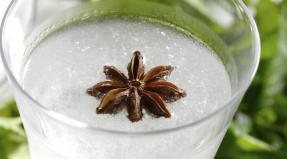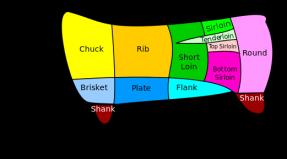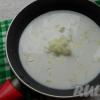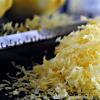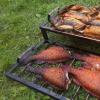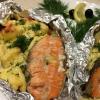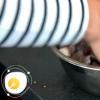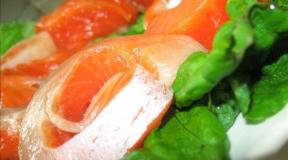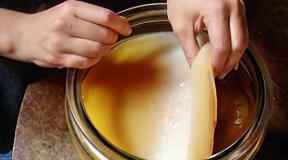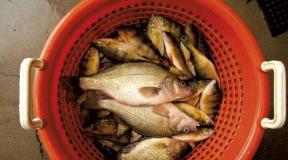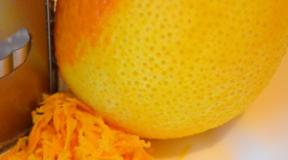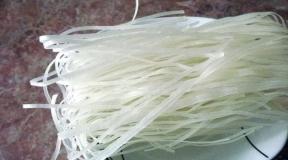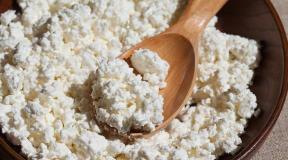Is the hare fish poisonous or not. Sea hare fish: what is useful, how to cook deliciously
For those who choose the beaches of Cyprus for their summer holidays, I will say right away: the rabbit fish does not pose any danger. It does not burrow into the sand like a scorpionfish. It does not attack a person, so it is with him in different weight categories, and it is found quite far from the coast. This story is more for those who are going to sea fishing.
Actually, it was because of the meeting with this strange, sperm whale-like fish that the idea was born to make a page about the dangers that await us in the Mediterranean Sea.
While walking along the beach in the fishing village of Liopetri, my sister noticed a rather large fish lying at the water's edge. The fish looked like a small sperm whale. First of all, the exquisite coloring of the fish caught my eye. Velvet black spots under a leopard on a gray back, a smooth snow-white belly made her irresistible. The whole thing was spoiled by the upper lip, like that of a rabbit, and even the head of the fish was about a quarter of the entire body. After taking a few pictures of outlandish fish, we went to the nearest fish restaurant to conduct a survey of the local population. I really wanted to know why such a luxurious fish was thrown ashore?
The owner of the restaurant, barely looking at the picture, immediately said his weighty "Oh!", which means "no" in Greek. A council of the owner's relatives, who immediately assembled, issued a final verdict: The fish is not edible and is called a rabbit fish. With that we left. At home, rummaging through the Internet, I attacked the trail of a mysterious rabbit. The Latin name Lagocephalus scleratus (by the way, Lagoscephalus is translated as hare-headed, th) says little to the vast majority of the population. But, oddly enough, many people know very well that the Japanese name is fugu. More precisely, the rabbit fish belongs to one of the many varieties of fugu. Often the British call this fish pufferfish, puffing fish, or, in Russian, ball fish.
The most important thing is that
- rabbit fish is a poisonous fish.
- this is an extremely aggressive species, displacing the indigenous inhabitants of the Mediterranean Sea.
- The number of aliens in the Mediterranean is growing day by day.
From the Internet and Cypriot newspapers to me
managed to extract some rather curious facts related to fugu. Believe them or not, decide for yourself.
1. Fish came to the Mediterranean from the Indian Ocean via the Red Sea as recently as 2005. She successfully acclimatized and began to breed.
2. The Cypriot authorities have announced a reward of 1 euro for every puffer fish caught. A certain Eleni, a resident of Larnaca, earned 1,000 euros in this way in a year.
3. Fugu poison does not lose its properties either during deep freezing or high-temperature processing. Several members of the crew of the Ukrainian ship, which was in the port of Haifa, Israel, caught, boiled and ate fugu. "All died from poisoning" - it was written on the Internet. However, I received a letter from Israel, from which I learned that, thanks to Israeli medicine, soup lovers, fortunately, managed to survive.
4. Cyprus plans to conduct commercial puffer fishing and is looking for markets. Negotiations are underway with China for the supply of the delicacy.
5. Back in 1598, a law appeared obliging a cook who cooks fugu to obtain a state license for this. It was this law that survived all the prohibitions and is still applied. A Japanese chef learns to carve fish for 2-3 years before getting a license. Then the cook must pass two exams - written and practical. Approximately three-quarters of applicants "fail" already in writing, for the delivery of which it is necessary to understand dozens of varieties of fugu, including various methods of "detoxification". And the remaining 25 percent are not issued licenses until they eat what they themselves have prepared.
6. The program on the National Geographic channel said that the fish is not at all as tasty as it is commonly believed. Its meat is quite tough. To make it chewable, the fish is cut into thin slices and served with spicy sauces.
7. The Japanese tradition of eating such a dangerous delicacy is not at all associated with an unearthly taste, as is commonly believed (see paragraph 6). It's all about the narcotic effect of microscopic doses of poison on the human body. They say that "fish does not show cartoons." "Coming" is something else. The nerve agent tetrodotoxin causes something like "tetanus" in minimal doses. A person sees everything, hears everything, but cannot move. Resistant to temperature effects, the toxin decomposes very quickly in the human body. The art of the cook lies in precisely dosing the poison. A well-known Soviet journalist who worked for many years in Japan, Vsevolod Ovchinnikov, in his "Sakura Branch" very colorfully describes his feelings from tasting fugu, similar to those mentioned above.
8. By analogy with Russian roulette, the tradition of eating fugu is called Japanese roulette. Every year from 10 to 100 people die from fish poisoning. These are either those who cooked the fugu themselves, or those who managed to persuade the cook to cook their liver for them. The liver is considered the most tender part of the fugu, but at the same time the liver is the most poisonous part of the fish.
And here is the latest news from the front of hostilities.
- The Cypriot authorities have increased the reward for each fish caught from 1 euro per head to 3.00 euros per kilogram of weight.
- An acquaintance who is fond of sea fishing says that the sea is simply teeming with this fish. The species is terribly aggressive, and it will not be easy for local fish to resist the unequal struggle with the alien if no measures are taken.
Addition to the article about rabbit fish
The picture, taken from the Greek Internet, clearly shows the fish's very characteristic "rabbit" nose. Thanks to him, the fish got its name and it cannot be confused with any other:

Here is a leaflet issued in Greece. The leaflet says:
"Ministry of Development of Agriculture and Food
Attention !
Poisonous fish.
Not edible"

Another version of the leaflet in the picture on the left, taken this time from the English site. In English, in particular, it is written that "the fish has a toxic skin and the poison does not decompose during heat treatment. Do not eat fish soups if you are not 100% sure that the fish is edible!"

And now the most important thing. In Cyprus and Greece, a wide campaign is being conducted, the purpose of which is to convey to every fisherman how dangerous this fish can be. But at the same time, I repeatedly heard and wrote to me that the rabbit fish is quite edible and they call it chicken fish. But in all cases known to me, the fish was carefully butchered, removing the skin from it. Which, in principle, is in good agreement with the information from the English-language site, given a little. So to be or not to eat or not to eat fish, everyone decides for himself.
On August 22, 2012, the Department of Fisheries visited. On the wall hangs a "portrait" of the ill-fated fish, either a rabbit or a chicken. When asked if the fish is poisonous, there was a not very clear answer. In general, either some organ in her is poisonous, or the toxicity of the fish depends on the season. But from which season and which organ is exactly unknown. Or maybe it's not poisonous at all. It is only certain that:
- There are a lot of fish.
- It is industrially caught and destroyed. The state pays 3 euros for each kilogram.
- There are people who ate it and survived.
So to be or not to eat or not to eat fish-rabbit-chicken, everyone decides for himself!
In some stores you can find exotic products that are unknown to many, and therefore cause distrust. Sea hare fish, the benefits and harms of which will be discussed, in the store can be mistaken for a more familiar hake or pollock, since the carcasses are sold without a head. Another name for this fish is a chimera. Those who have tried this product like the fact that instead of bones, this fish has breast-like cartilage, and there are no small bones at all. The meat is very tasty and juicy.
The benefits and harms of a bearded seal
Until the beginning of the 20th century, the chimera was considered an inedible fish, but today, in many restaurants in Europe, its fillet is considered a real delicacy. The beneficial properties of chimera fish are justified by the presence of a large amount of easily digestible protein, E, D, as well as various minerals. Given the presence of fatty acids, chimera fish is very nutritious. Many are interested in calorie content, and so 100 g of the product contains 116 kcal.
As for the harm of hare or chimera fish, some people may have an individual intolerance to the product. It is worth saying that the upper fin of this fish is poisonous, so you need to cut the carcass as carefully as possible. Since the chimera is an oily fish, you should not eat it in large quantities.
Fish hare in pots
Ingredients:

Cooking
Remove the spine from the steaks and cut them into small squares. Chop the vegetables and cheese into small cubes, and chop the greens. Combine ingredients and add lemon juice to it. To prepare the dressing, combine oyster sauce, olive oil and season with salt and pepper. Arrange in pots, add butter and sprinkle with cheese. Pour in the dressing, put in the oven and cook at 200 degrees for 20 minutes.
The sea hare is a tasty and healthy fish. It contains a large amount of easily digestible protein, vitamins A, E and D, macro- and microelements, as well as fatty acids, making meals very nutritious. The main thing is to choose the right semi-finished product. The sea hare is a fish sold frozen in our country. Moreover, it is recommended to buy a whole carcass, not a fillet. Her eyes should be transparent and shiny, and her gills should be closed and have a red color. Cutting the carcass does not take much time. Now you can start cooking.
Fish "Hare". Recipe with tomatoes
To prepare the dish, you will need to make a fillet and cut it into pieces of one hundred grams. Put rice to boil, as usual for a side dish. Cut four tomatoes into medium cubes, put in a deep saucepan. Put them out a little under the lid over low heat. Next, add six chopped garlic cloves, a large spoonful of your favorite seasoning, salt, bay leaf, dry parsley and ground pepper to the sauce. Simmer covered for another five minutes. Place the fish pieces in the pan. The dish will be ready in twenty minutes. Serve with rice and drizzle with sauce.
Sea hare (fish). Recipe with cheese

To prepare the dish, it is necessary to cut the fish into thin plates (the weight of each of them should be no more than one hundred and fifty grams). Make a breading by mixing a glass of breadcrumbs and finely grated parmesan with a pinch of salt. Beat the egg very well. First, roll each piece of fillet in flour. Then dip it into the beaten egg and finally into the breading. If desired, these steps can be repeated again. Fry for five minutes on each side. If desired, the dish can be baked in the oven at a temperature of two hundred degrees. This will take no more than fifteen minutes.
Sea hare: "Fish to beer"

To prepare the dish, you first need to make a pound of fillet and cut it into small thin pieces. The semi-finished product should not be completely defrosted. Coat each piece thickly with cayenne pepper and leave for half an hour. After the fish is completely defrosted, roll portions in cornmeal, to which it is recommended to add a little black pepper and salt. Heat a deep saucepan, add a glass of vegetable oil to it. Fry the pieces in boiling fat for three to five minutes on both sides. Then put them on paper towels for a few minutes. This will remove excess oil. This dish can be served either hot or chilled.
Sea hare: "Fish with garnish"

First you need to boil the rice, as usual. Next - in one pan, fry a portioned piece of fish, weighing no more than two hundred grams. Put mugs of one onion and cubes of four tomatoes in a deep stewpan. Simmer the sauce for five to seven minutes. Then add to it five chopped cloves of garlic, ten olives, cut into circles, salt and black pepper. Simmer the sauce for ten minutes. Spread on a plate as follows: first - a hill of rice, then - a piece of fish, pour sauce on top. Enjoy your meal!
The most inexperienced housewives know how to fry fish, but I will still take the liberty of writing a review on this topic. I am writing because we are talking about a fish called a chimera. In the English version, it is called Rabbit Fish, we sell it under the name hare fish, I also heard the name rabbit fish. There is a lot of information on the Internet about this fish, which is extremely contradictory. Since I cooked this fish more than once, I can say that this fish is worth a try. Not everyone likes her taste. My daughter and I like her, the cat is wildly delighted, but her husband did not like her. Since the chimera fish is sold in frozen form, it must first be thawed, I fill it with cold water and leave it alone for about a couple of hours.
The chimera fish has large fins and some kind of fins on its back, from head to tail. There are no scales on the fish and I like it, it is enough just to wash the belly well.

I cut off the fins completely and throw them away.

I cut the fish into portioned pieces, while cutting the peel.

I salt and roll each piece in flour on all sides.

I fry in sunflower oil on both sides over low heat for about 7 minutes on each side. I didn’t notice any fishy smell when frying, it smells nice.
Fish in finished form does not have a presentable appearance. It will not decorate a festive table, there is no bright crust inherent in any fried fish.

The chimera fish has absolutely no bones; instead of a ridge, it has cartilage. Too bad the photo can't show how small this cartilage is. By the way, the cat ate cartilage with no less pleasure than the fish itself.

The fish is not at all oily, it seemed tough to my husband. My daughter does not like fish and avoids fish dishes, she really liked this fish. The fish is really not very hard, but I have not eaten such a tasty fish for a long time, although I buy fish very often. I can't even compare its taste to any other fish. Although the lady in the queue (and for such a fish, when it is on sale, you have to stand in line) told me that the taste of chimera fish is similar to the taste of sturgeon. I have never bought a sturgeon, so I can not compare.
I serve the chimera fish with rice and salad, the rice blended very well with this fish.

The time indicated is only for frying fish, the time for defrosting it was not taken into account.
Bon appetit and creative culinary inspiration. I think there is a lot to try on your own. And do not rely entirely on the opinion of some people. I cooked chimera fish in a stew with vegetables, I will write a review later, as soon as I can buy a fish. Despite its not very small cost (89 hryvnia per kilogram), I am buying up a chimera fish at the moment and now I have to wait for the next delivery.
Time for preparing: PT00H30M 30 min.
This fish does not belong to the most popular marine life. It is quite rare and many, having heard the name, will not even understand what it is about. Let's try to eliminate this ignorance a little. Chimera fish refers to the bottom and deep-sea inhabitants of the deep sea. This applies to all of its known varieties. It is distributed in all oceans and seas of the Southern and Northern Hemispheres. It feeds on small fish, crustaceans, mollusks and starfish. It has a length of up to one and a half meters.
general information
The chimera fish, despite being clumsy and slow, is well adapted to finding prey at the bottom of the sea, such as shellfish. Some varieties of this underwater inhabitant are armed with a dorsal poisonous spike, which is an unexpected and real surprise for sharks and other predators who dare to attack him.
Let's find out what a chimera is.
The fish, the photo of which is in front of you, looks very funny, but that is until you find out about its poisonous weapon. How does she look for a tasty treat for herself in the dark, silt and algae? The chimera is superbly helped in this by its nose, which digs the bottom of the sea and has special receptors for searching. She lives and hunts mostly in shallow seas, but there are representatives who prefer to look for prey in deep waters.
Features of the chimera

"Silver Pipe" - the so-called chimera in New Zealand, served on the table fried and with chips. And White Fillet is an Australian delicacy. Let's say you caught a chimera fish. Can you eat it? The answer is simple - of course you can.
Types of chimeras and their habitats
There are three main types of our fish:
- The plow-headed chimera belongs to the family Callorhynchidae, lives in coastal shallow water and, thanks to its sensitive, unusually shaped snout, successfully finds mollusks in the sandy bottom.
- Blunt-nosed, belongs to the Chimaeridae family, lives in deeper and darker waters, up to 500 meters deep. Thanks to its super-sensitive eyes, the ghost shark quickly and easily spots starfish and other native sea creatures suitable for eating.
- The long-nosed chimera fish from the Rhinochimaeridae family lives at even greater depths and has a sensitive elongated snout that is designed to look for mollusks where there is no light at all.
The very same chimera fish, the photo confirms this, is very beautiful, with silvery spotted sides.

Chimera fish: how to cook in the oven
People from the camp that decided that it is quite edible claim that sea rabbit dishes are very tasty. In addition, on the shelves of stores now you can often see this delicacy. There is one plus here - the creepy-looking chimera is sold already cleaned. Here we are, at the end of our introductory article, we will tell you the recipe for cooking our fish with vegetables in the oven.

To do this, we need the following ingredients: one sea rabbit carcass, one carrot, one onion, fish seasonings, salt, half a lemon and a few tablespoons of vegetable oil.
The process of cooking a chimera in the oven
Let's start cooking with vegetables, as they must first be stewed. We clean the carrots and rub on a coarse grater. We put the pan on the fire, pour a little vegetable oil and spread the vegetable. Next, we clean it much more tenderly than usual to taste, cut it into half rings and also put it in a pan. We mix the vegetables, salt, add a little water (a few tablespoons) and close the lid. Stirring from time to time, simmer until fully cooked. It's time to take on the fish. We cut off the short fin on the carcass with scissors. After that, cut it into small pieces. Pour seasonings and salt into a small saucer, mix them and rub each piece of fish with this mixture.

She will marinate while our vegetables are stewed. As soon as the onions and carrots are ready, we take a baking dish and transfer the vegetables to it. It is not necessary to pre-grease the baking sheet with oil. Next, put pieces of chimera fish on top of the vegetables and squeeze the juice of half a lemon onto it. We heat the oven to 200 degrees, send the form into it, and after 20 minutes the delicious dish is ready. Serve hot with rice or mashed potatoes. Enjoy your meal!
